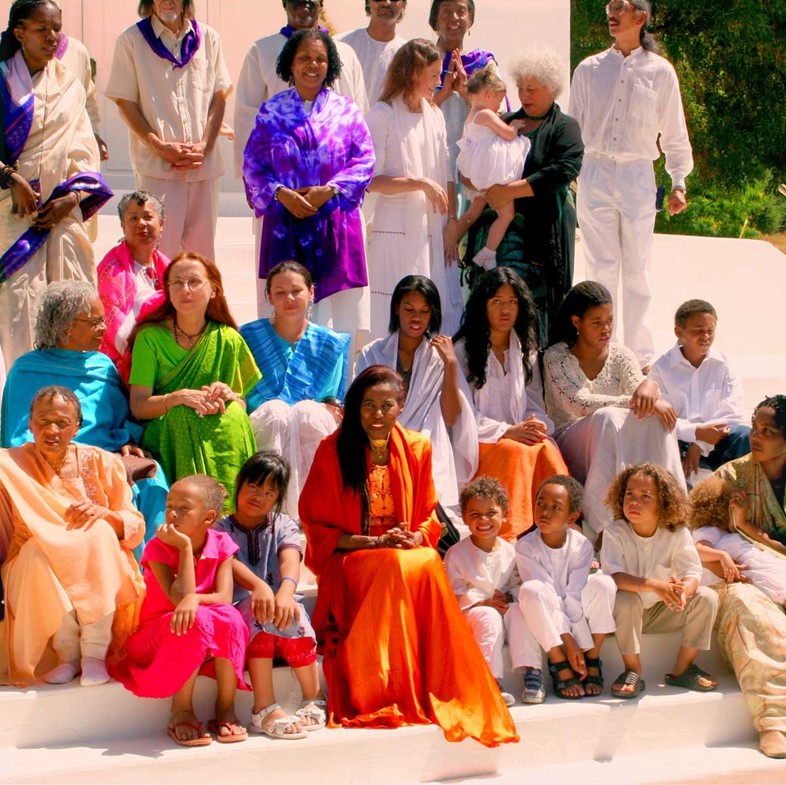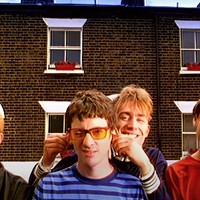After her husband’s death, the legendary jazz artist recorded some jaw-droppingly beautiful devotional music – almost lost to time, these albums are now seeing the light of day again
Ten years ago, American jazz pianist, organist, harpist, singer, composer, and spiritual teacher Alice Coltrane Turiyasangitananda passed from this world to the next. In life, Alice Coltrane was a visionary with an extraordinary story, but until recently her legacy has been at least partially obscured by that of her long-departed husband John Coltrane, arguably the greatest jazz saxophonist of his generation and an incalculable influence on the genre. In the years following John’s death in 1967, Alice underwent a series of revelations. After releasing a remarkable run of cosmic jazz albums in the late 1960s and 70s and pilgrimaging to India, these revelations led her to establish an ashram (a religious retreat) outside of Los Angeles and create a singular form of devotional music that could only be born from a life lived through the peaks and valleys of total ecstasy and inescapable agony.
Though once a relatively obscure part of the musician’s history, Alice Coltrane’s worship recordings have become an increasingly frequent topic of discussion in recent years. With Vedic chants punctuated by handclaps and tambourines, these songs differ from the Indian and Nepalese devotional music in their use of celestial, star-spanning synthesiser, organs, strings, and drones, Western melodies and composition, and vocals tempered by the Detroit church choirs of her youth. It’s music that truly sounds like nothing else, born from her need to create for and with her spiritual community. It’s music that only she could have made.
Born Alice McLeod in Alabama in 1937, Alice Coltrane spent her childhood and teenage years on Detroit’s east side. The fifth of six siblings in a musical family, she took up piano and organ at a young age. By the time she was 16, Alice was accompanying several local choirs and gospel groups. It was through these experiences that she first connected with the idea of devotional music. At the same time, the city’s burgeoning jazz scene was calling, and Alice became a familiar player around town before heading to Paris with her first husband, a jazz singer named Kenneth ‘Poncho’ Hagood.
There, she forged musical connections with players like Bud Powell, Lucky Thompson, and Kenny Clarke. She performed around the Parisian capital, took part in televised jazz broadcasts, and in 1960 she gave birth to her first daughter Michelle. But Kenneth was using heroin, and as his habit grew, Alice returned to Detroit with her daughter and moved back in with her parents. Back in Motor City, she returned to the local circuit and was captivated by the widescreen visions that John Coltrane was expressing with his albums of the time. Alice saw John perform in Detroit in 1962, and a year later she opened for him in New York with vibraphonist Terry Gibbs ensemble. With time, they’d forge a relationship, and in 1965 – two years after their relationship began – they married in Juarez, Mexico. Yet by 1967, John would be dead from liver cancer. The flame that burns twice as bright burns half as long.
During their time together, Alice and John had three sons – John Jr., Ravi, and Oran – and stepped beyond the framework of their traditional Christian upbringings, exploring Hinduism, Zen Buddhism, and Hare Krishna practices in their search for something sublime and higher. With this deep dive came John’s titanic masterwork A Love Supreme, and other freeform records that looked towards the light in their own way. After John’s death, Alice went without food and sleep for days, suffering from hallucinations along the way. Her spiritual drive pushed her towards the Vaishnavism branch of Vedic religion, and she met the Indian spiritual master Swami Satchidananda. In his teachings, she found a sense of connection between the individual and the infinite. Alice also learned to play harp, and began recording and performing with the crucial open-eared jazz musicians of the era. A series of incredible albums followed, mostly released through Impulse! or Warner Bros. Records. In 1970, she travelled to India with Swami Satchidananda on a five-week pilgrimage. Upon returning home, a higher force instructed her to establish an ashram of her own.
“Fully hearing the music Alice invented... made me realise what a complete world she had created, and how extraordinary and beautiful that is” – Yale Evelev, Luaka Bop
As a jazz fan in the 1970s, Yale Evelev saw Alice Coltrane perform and owned many of her records. As president of Luaka Bop (the New York record label first established by Talking Heads frontman David Byrne), Evelev has overseen recent reissues of lost Nigerian electro-funk pioneer William Onyeabor and outsider San Francisco musician Doug Hream Blunt. Earlier this month, the label released World Spiritual Classics: Volume I: The Ecstatic Music of Alice Coltrane Turiyasangitanana, a retrospective compilation of Alice’s devotional music, most of which was released on four cassettes between 1985 and 1995. Evelev had been aware of these tapes at the time, but only listened to them seriously after prompting from Prince Language, a Chicago-born house DJ, remixer, and re-editor with encyclopedic music knowledge and a special touch. Prince Language suggested he play all four releases together and sent him a mp3 folder. “That’s what blew me away,” Evelev admits. “Fully hearing the music Alice invented, a mixture of the gospel she grew up with, jazz, (the music from) her travelling to India – her entire life and all of what that entails – made me realise what a complete world she had created, and how extraordinary and beautiful that is.”

Alice relocated her family to California in 1972. Three years later, she established the Vedantic Center at her home in Woodland Hills, north of Los Angeles. Around this time Purusha Hickson, one of Alice’s early spiritual students and today a Los Angeles-based hatha yoga teacher, discovered Alice’s music while volunteering at the One Mind Temple in San Francisco. The Temple would serve free hot vegetarian meals and play John’s music. One night, someone placed Alice’s Universal Consciousness LP on the record player. “When I heard it, I knew right away that this person had a higher understanding,” he reflects.
Not long afterwards, she performed in Los Angeles. Hickson scheduled travel arrangements, attended, and met with Alice. “There was nothing ostentatious about her,” he recalls. “She was about as down to earth in one way, as anyone could be, but there was a mystical energy about her that was undeniable.” A year later, he took initiation with Alice at The Vedantic Center. “She became Swamini Turiyasangitananda to me,” Hickson continues. “She was a living example of someone I believe was in contact with the most high. She would say, ‘Look, you have the same capacity. This isn't something unique to me, but you have to cultivate that awareness within yourself.’ She was my guru, my mentor, my teacher, and an example of where I want to go in consciousness.” On Sundays, Alice would lead her students in devotional Vedic ceremonies. They would perform solo and group chants, and with time, she began to add synthesisers to the proceedings. “It was like Swamini was this divine conductor,” Hickson enthuses. “She would be communicating with this higher force. The music would build… and she would take us to some high devotional places. It was a village sound man. Everyone contributed to the energy we were building whatever way they chose to. It really felt like a spiritual high.”
“When I heard her sing, there was such a force in her voice... It was another energy moving through her, and it was wonderful” – Purusha Hickson, early spiritual student of Alice Coltrane
At the center of this world sat the one instrument that Alice had never used before – her voice. Hickson was amongst the first to hear her sing. “One particular evening, Swamini announced she’d made some cassette tapes for us,” Hickson recalls, speaking in soft Californian tones. “We all had walkmans back then, so we listened individually on headphones.” The cassettes in question were copies of 1982’s Turiya Sings, the first of the four extremely rare devotional tapes she released through Avatar Book Institute, an obscure private press label also headquartered at Alice’s Vedantic Center. “When I heard her sing, there was such a force in her voice. She said, ‘Look, this is god manifesting. This is the divine that has allowed me to do this.’ It was another energy moving through her, and it was wonderful.”
Slowly but surely, Alice’s cassettes began to be heard beyond the ashram. By way of dubbed copies, mp3 folders, and shared YouTube uploads, they connected with not just a new generation of listeners, but a new wave of musicians. “Right away the album since a chill down my spine and by the time the second song of the album played I was tearing up,” reflects New Orleans-based beatmaker AF THE NAYSAYER, a rising voice in the North American instrumental hip hop underground. “I’d just felt a staggering spiritual connection with the music on Turiya Sings, and I’m by no means a religious practitioner.”
“There does seem to be a point where a life saturated in sound leads someone back to their heart and their own vast, silent beingness,” muses New Zealand-born producer and DJ, Fis. A mercurial force within experimental music circles, in recent years Fis has drunk deeply from Alice’s wellspring of inspiration while expressing unique techno-ecological musical visions through EP and album releases on Tri Angle, Loopy, and Subtext. “It’s telling to try and imagine the world suddenly deprived of her music, and everyone else’s music for that matter – I get an instant sense of collapsed dimensionality and crushingly tight space. I think Coltrane was a master at offering space through music, particularly prayer space and cosmological expansion. There are things I couldn’t have perceived or felt without her work.”
In 1982, another tragedy befell Alice’s family. Her oldest son, John Jr., died in a car accident. He was barely 18. With deep sadness often comes deeper introspection, and the experience led once again to spiritual revelations. Finding solace in the Vedantic belief in reincarnation, Alice continued on, and a year later opened the 48-acre Sai Anantam Ashram in the Santa Monica Mountains of Agoura, California. Over time, her spiritual community grew, drawing in a diverse mixture of African-American, Latin, Caucasian, and Indian members, all of whom would gather for music on Sundays. One of the youngest attendees was her great-nephew Steven Ellison, who now articulates his own widescreen musical visions as Flying Lotus.
Alice Coltrane has been gone for a decade now, but under the global political and social climate of 2017, the meditative and healing qualities of her music feels more relevant and sheltering than ever before. Earlier this month, Hickson and a group of her ashram singers gathered at New York’s Knockdown Center venue to perform the music they used to share with Alice. The audience greeted them warmly. For Hickson, the reception came with a revelation. “The best metaphor I have for it is this,” he explains. “Elders plant fruit trees in the backyard and tend to them, knowing that the trees will take a while to mature and they themselves will never eat that fruit. They tend to those trees with love and care, because they know the fruit is going to benefit others with time. That’s how I feel this music is with Swamini. There was an urgency for it to be completed. Somebody understood that all of this would be happening, and did work and effort with this intent, and here we are, part of that. That’s amazing to me.”
World Spiritual Classics: Volume I: The Ecstatic Music of Alice Coltrane Turiyasangitananda is out now through Luaka Bop




